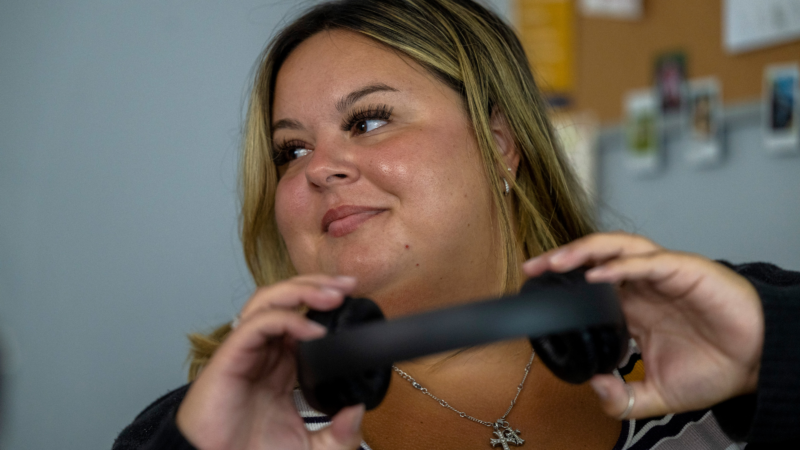Burnout is a problem for caseworkers serving unhoused people
When someone seeking housing assistance in central Connecticut calls the state’s 211 helpline, they’re often directed to Nicole Barracliff.
She sits in her office, cradling a pink mug of coffee with an image of a Care Bear on the front, talking on the phone with a man facing homelessness.
“They’ll provide you anything they have to keep you as safe and comfortable as possible, but they wouldn’t be able to offer you, like, an immediate shelter bed anywhere, unfortunately,” Barracliff told him.
She’s talking about the nonprofit Community Housing Advocates, where she’s been connecting people with services for the past three years. Most are unhoused or facing eviction. For the last three years Barracliff has been helping them find a temporary or permanent place to stay.
Last year, there were more than 20,000 calls for aid across Connecticut, according to Community Housing Advocates. The calls are from people looking for everything from shelter beds to help finding an apartment.
Barracliff has felt overwhelmed since late 2023. With the loss of state and federal COVID-19 benefits came an increase in demand for housing.
Baracliff often finds herself having to tell clients there’s no immediate housing option.
“Small success stories, they do help, and they mean a lot,” Barracliff said. “They make your heart happy, but there’s just so many like, day to day. I feel like, you just feel like you’re never doing enough.”
The homelessness crisis deepens
Nationwide, homelessness increased 18% last year.
Inflation, rising housing costs,and the expiration of benefits are among the reasons for the increase. Providers are also unsure what to expect from the new presidential administration.
The National Alliance to End Homelessness chose not to speculate on how President Donald Trump’s policies may impact funding and support, but said it’s keeping an eye on the actions of new Department of Housing and Urban Development Secretary Scott Turner. The Alliance relies on federal funding in the form of grants.
To decompress, Baracliff takes midday walks or unfolds the futon in her office.
“If we have a really bad phone call, I’ll open it up and just like, sit by the window with the air and like, just have a moment,” Barracliff said.
Case worker challenges
While worker burnout was exacerbated by COVID, it’s been ongoing for years.
In some communities, federal pandemic aid made little impact for the organizations serving homeless people, according to Joy Moses, a Vice President at the National Alliance to End Homelessness.
“They had an influx of resources that came from the federal government that they were having a hard time spending because they just didn’t have the staff, the manpower to carry out the good ideas,” Moses said.
She said providers are taking on some of the trauma their unhoused clients share with them, and there are no standardized training or programs for providers to address the additional burden.
Another issue caseworkers face is relatively low pay. More than half of the homeless service providers surveyed in a recent study by the Alliance made less than $55,000 annually.
Low pay also leads to high employee turnover and that impacts care, according to Kellyann Day, Chief Executive Officer of the nonprofit New Reach, which operates two shelters in Connecticut.
New Reach’s turnover has risen to about 20%, Day said.
“In many cases, it’s doubled some years. Our turnover used to be well under 10%,” Day said.
‘Not any right answer’
For Barracliff, who works connecting unhoused callers with help, the pain of her job springs up at odd moments.
“When you’re driving around in your car with your kids, you’re laughing, you’re going to football, and you’re doing normal things, and you look over and you see somebody not doing those things, because they can’t, that are very clearly unhoused,” Barracliff said.
Affordability is the main concern and more affordable apartments around Connecticut would help, Barracliff said.
“People who even have income can’t afford a unit, or to keep up with a unit,” Barracliff said. “We’ve gotten clients a security deposit, and they end up in a unit, and then the rent raises and they can’t afford it. They’ll call back next year. There’s not any right answer.”
For many providers, it comes down to resources and funding. Workers will be able to better care for unhoused residents, if they don’t feel at risk of being unable to afford housing themselves.
Transcript:
MICHEL MARTIN, HOST:
As the cost of housing keeps going up, so does the number of people without a stable place to live in the U.S., and many of the caseworkers who help them are feeling burned out. Connecticut Public Radio’s Abigail Brone has this report.
ABIGAIL BRONE, BYLINE: When someone seeking housing assistance in central Connecticut calls the state’s 211 helpline, they’re often directed to Nicole Barracliff. She’s sitting in her office, cradling a pink mug of coffee with an image of a Care Bear on the front. She’s on the phone with a man facing homelessness.
NICOLE BARRACLIFF: They’ll provide you anything they have to keep you as safe and comfortable as possible. But they wouldn’t be able to offer you, like, an immediate shelter bed anywhere, unfortunately.
BRONE: For the last three years, Barracliff has been connecting people who are unhoused or facing eviction to services that can help find them a temporary or permanent place to stay. Barracliff says she’s felt overwhelmed since late 2023. With the loss of state and federal COVID benefits came an increase in demand for housing. She often finds herself having to tell clients there’s no immediate housing option.
BARRACLIFF: Small success stories – they do help, and they mean a lot. Like, they make your heart happy. But there’s just so many, like, day to day. I feel like – you just feel like you’re never doing enough.
BRONE: Last year, there were more than 20,000 calls for aid across Connecticut – people looking for everything from shelter beds to help finding an apartment. Nationwide, homelessness increased 18% last year, according to a federal report. Inflation, rising housing costs and benefits expiring are among some of the reasons for the increase. And providers are unsure what to expect from the new presidential administration. The National Alliance to End Homelessness chose not to speculate on how President Donald Trump’s policies may impact funding and support. To decompress, Barracliff takes midday walks or unfolds the futon in her office.
BARRACLIFF: If we have a really bad phone call, I’ll open it up and just, like, sit by the window with the air and, like, just have a moment.
BRONE: While worker burnout was exacerbated by COVID, it’s been ongoing for years. Joy Moses with the National Alliance to End Homelessness says in some communities, federal pandemic aid made little impact for the organizations serving homeless people.
JOY MOSES: They had an influx of resources that came from the federal government that they were having a hard time spending, because they just didn’t have the staff and the manpower to carry out the good ideas.
BRONE: Moses says providers are taking on some of the trauma their unhoused clients share with them. Another issue caseworkers face? Relatively low pay. A recent study by the alliance found more than half of the homeless service providers surveyed made less than $55,000 a year. Low pay also leads to high employee turnover, and that impacts care. Kellyann Day is CEO of the nonprofit New Reach, which operates two shelters in Connecticut. Day says New Reach’s turnover has risen to about 20%.
KELLYANN DAY: In many cases, it’s doubled. Some years, our turnover used to be well under 10%.
BRONE: For Barracliff, who works connecting unhoused callers with help, the pain of her job springs up at odd moments.
BARRACLIFF: When you’re driving around in your car with your kids and, like, you’re laughing, and you just – you’re going to football, and you’re doing normal things. And you look over, and you see somebody not doing those things, because they can’t, that are very clearly unhoused.
BRONE: For many providers, it comes down to resources and funding. Workers will be able to better care for unhoused residents if they don’t feel at risk of being unable to afford housing themselves. For NPR News, I’m Abigail Brone.
(SOUNDBITE OF MUSIC)
DHS ends Temporary Protected Status for thousands from Nicaragua and Honduras
Some 76,000 people from Nicaragua and Honduras were covered by TPS, which provides protection from deportation and grants work permits to people from certain nations affected by war or natural disasters.
BRICS nations push back as Trump warns of tariffs
Leaders of the BRICS group of emerging economies meeting for their annual summit had hoped to downplay any differences with the U.S. But even a toned down group proclamation drew the ire of President Trump.
DOJ says no evidence Jeffrey Epstein had a ‘client list’ or blackmailed associates
The two-page memo outlines the "exhaustive review" the department conducted of the Epstein files in its possession, and also reiterates that Epstein died by suicide, contrary to some conspiracy theories.
Floods are getting more dangerous around the country, not just in Texas
The deadly floods in Central Texas were caused by extremely heavy rain. Climate change is causing even more rain to fall during the heaviest storms.
Near old Montana mine, special clinic for asbestos-related illness fights to survive
The Center for Asbestos Related Disease in Libby, Montana, closed in May after a court judgment. The clinic's federal funding is also threatened. Patients with scarred lungs worry about what's next.
4 things to know about the deadly Texas floods and ongoing search efforts
Search efforts continue for the dozens of people still missing after Friday's floods, as questions swirl over what went wrong. Here's what we know so far.






